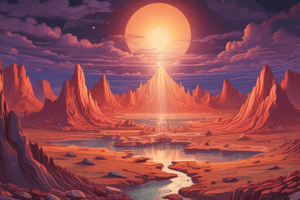Podcast
Questions and Answers
What is the lithosphere composed of?
What is the lithosphere composed of?
the entire crust and the uppermost mantle
What is the asthenosphere?
What is the asthenosphere?
a layer of low rigidity that separates the rigid lithosphere from the rigid mantle
Where does most of Earth's volcanic and earthquake activity occur?
Where does most of Earth's volcanic and earthquake activity occur?
at the edges of lithosphere plates
What is the eastern edge of the North American continent?
What is the eastern edge of the North American continent?
What is the eastern edge of the North American plate?
What is the eastern edge of the North American plate?
In the tectonic cycle, new lithosphere forms at _____________ and is consumed at _____________
In the tectonic cycle, new lithosphere forms at _____________ and is consumed at _____________
Volcanic activity is abundant at all of the following locations except at certain areas.
Volcanic activity is abundant at all of the following locations except at certain areas.
Where do earthquakes occur frequently?
Where do earthquakes occur frequently?
What is the only type of plate boundary without vertical transfer of material between the lithosphere and asthenosphere?
What is the only type of plate boundary without vertical transfer of material between the lithosphere and asthenosphere?
How did the Himalayan mountain system form?
How did the Himalayan mountain system form?
Where do volcanic arcs form?
Where do volcanic arcs form?
What happens when a seamount forms?
What happens when a seamount forms?
Flashcards are hidden until you start studying
Study Notes
Lithosphere and Asthenosphere
- Lithosphere includes the Earth's crust and the uppermost mantle.
- Asthenosphere is a layer of low rigidity that separates the rigid lithosphere from the underlying rigid mantle.
Plate Boundaries and Geological Activity
- Most volcanic and earthquake activity occurs at the edges of lithosphere plates.
- Volcanic activity is abundant at various geological features, excluding one not specified.
- Earthquakes commonly occur at plate boundaries.
North American Continent and Plate
- The eastern edge of the North American continent coincides with the edge of the continental shelf, marking the transition from continental to oceanic crust.
- The eastern edge of the North American plate is identified as the Mid-Atlantic Ridge, where sea-floor spreading occurs.
Tectonic Cycle Insights
- In the tectonic cycle, new lithosphere is formed at ocean ridges and is consumed at subduction zones.
- Volcanic arcs develop above subduction zones where oceanic lithosphere is being subducted.
Transform Faults and Vertical Material Transfer
- Transform faults are characterized by the absence of vertical transfer of material between the lithosphere and asthenosphere.
Mountain Formation
- The Himalayan mountain system emerged as a result of subduction, closing an ocean that once separated India and Asia.
Seamounts
- A seamount occurs when a volcanic island erodes over time and sinks due to increased density.
Studying That Suits You
Use AI to generate personalized quizzes and flashcards to suit your learning preferences.




